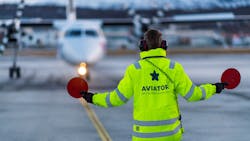Digitization in Aviation Brings Solutions for Efficiency
Digitization in aviation has been on a rapid upward trend before the pandemic hit. The industry was making strides in accomplishing its digital strategies – investing in cloud services, data centers, and more – and continued to do so all throughout the pandemic. Now, new technologies and innovations appear in a number of aviation segments, bringing improved efficiency across the industry.
While it would seem that the two years of pandemic lockdowns and restrictions hindered the progress aviation was digitizing many aspects of the industry, in reality, many businesses and services continued the process. Magnus Söderberg, business improvement director at Aviator Airport Alliance, a Nordic one-stop shop for aviation services, is, too, seeing how the technology is bringing efficiency up.
“We’re currently witnessing quick progress being made in the aviation industry by implementing and adopting new technology. It improves efficiency through eliminating or reducing spent resources in terms of time and money. Introducing new technology, whether it be software or equipment, minimizes manual tasks, and wasted time spent on waiting or searching for information as well as reduces the consumption of raw materials,” he says.
Technologies in Aviation at Play
Söderberg notes that some of the examples of technologies currently used to bring more efficiency to day-to-day processes are software to automate arrival services, using electric ground support equipment (GSE), and its geolocation tracking.
Other adoptions of technologies, which might sound more familiar to an everyday flyer, are self-service bag drop-off solutions as well as online check-ins, which reduced long queues at airports and brought down the handling time of an aircraft. The so-called ‘bag journey’ or luggage tracking software allows the passengers to be able to have more control over their luggage immediately after they drop it off and until it arrives. This has greatly reduced the number of lost and delayed luggage.
“The digitization in aviation has brought heaps of more efficient solutions for both passengers and the industry, which is now seen as an integral part of the flying experience – both commercial and private – and the everyday processes done by ground handling teams, as well as maintenance, repair, and overhaul specialists,” notes Söderberg. “And there are many other new technologies already created or being developed right now that further the automatization of the processes in the industry.”
The Impact of Adopting New Technologies
Söderberg notes that the impact of the adopted technologies is most of the time immediate, though there are exceptions. If the technological solution in question facilitates a process or procedure by taking away manual tasks the impact is instantaneous. However, if it concerns data and information, the impact could be both.
“If the adopted technology enables us to have better, quicker, and more precise information like GSE tracking provides, it will in time change the processes and behaviour, allowing us to make decisions based on the new information. But it can be immediate if, for example, we purchase an electric GSE. While then the effects are instant – not on operations themselves, but in terms of emissions, cost, and noise reduction.”
The changes – implementing technologies to up efficiency – are bringing many positives to the overall industry, and Aviator notices that, too. Providing aviation services from passenger and baggage handling to de-icing, cargo, and full freight handling to station services, the company has been driving the implementation of green GSE. According to Söderberg, this is an essential part for Aviator as reducing carbon emissions will ensure sustainable operations for the future.
During the pandemic, the industry wasn’t sure how and when it would recover, so it had to adapt for the time being and think about the possible post-pandemic aviation landscape. But this period only strengthened the need for innovative solutions in aviation. New technological advancements brought changes that now are an essential part of aviation and further digitizing processes could bring even more efficiency to the aviation industry as a whole.
